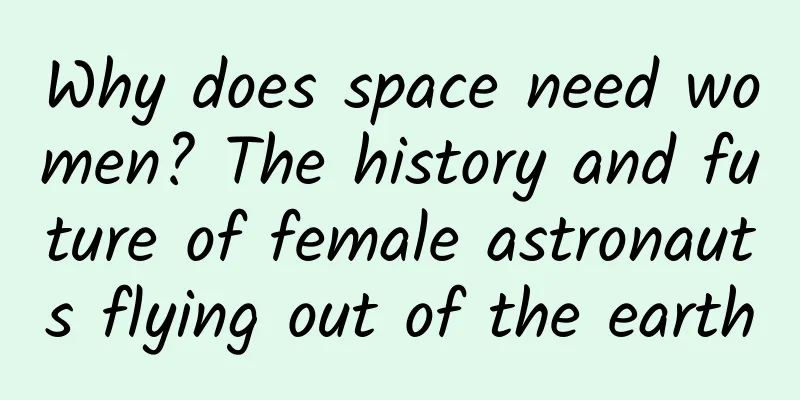Why does space need women? The history and future of female astronauts flying out of the earth

|
According to the China Manned Space Engineering Office on October 29, 2024, the astronaut crew for the Shenzhou 19 manned flight mission will be composed of three astronauts, Cai Xuzhe, Song Lingdong and Wang Haoze, after research and decision by the Space Station Application and Development Phase Flight Mission Command. The crew includes one astronaut from the second batch and two astronauts from the third batch. Among them, astronauts Song Lingdong and Wang Haoze are "post-90s" who are performing a flight mission for the first time, and astronaut Wang Haoze is the first female space flight engineer in my country. More than 500 people have entered space, of which about 60 are women, accounting for about 10% of the total number of astronauts. Among the more than 200 astronauts who have completed space extravehicular activities, 16 are women, and the 16th is China's first "space teacher" Wang Yaping. During the Shenzhou 13 mission, she not only became my country's first female astronaut to perform an extravehicular mission, but also conducted space teaching activities again and brought my country's traditional art into space. Wang Yaping plays "Jasmine Flower" | Source @Our Space Space belongs to all mankind, and female astronauts have written a great female epic on the canvas of space. 1. The beginning of the epic The first female astronaut was Tereshkova from the Soviet Union, but women's journey into space began as early as 1959. That year, Gagarin had not yet entered space, Eisenhower, who was trying hard to prevent the United States from being hijacked by the military-industrial complex, was still the President of the United States, and the issue of gender equality only existed in places where the international communist movement was thriving. In early 1959, Brigadier General Flickinger, then commander of the U.S. Air Force's Aeronautical Research and Development Command, and Lovelace, then chairman of NASA's Special Advisory Committee on Life Sciences, jointly developed a plan to select female astronauts. In 1995, the seven members of the Mercury Project 13, Jerry Cobb (third from left) and Wally Fink (second from left) | Source @wikimedia At that time, the US Mercury-Redstone 3 rocket was far inferior to the Soviet R-7 rocket of the same period. In the manned space battle of the US-Soviet space race, women with lighter weight, lower oxygen consumption and better tolerance to confined spaces were believed to be able to make up for the shortcomings of rockets and help the United States turn defeat into victory. Therefore, the United States selected 13 reserve female astronauts, who were later called the "Mercury Project 13 Women", through a set of physiological and clinical standards divided into four stages and including many cruel tests. Wally Fink (first from right) going into space with Bezos in 2021 | Source @blue origin Unfortunately, these 13 female civil aviation pilots underwent tests including swallowing rubber tubes into their stomachs, electric shocks, and injecting ice water into their ears, but were ultimately excluded from the "Mercury Project" by NASA. Thus, the baton of the first chapter of the epic of female astronauts was handed over to the Soviet Union, where men and women were paid equally for equal work, and to Tereshkova. In 1961, after Gagarin became the first human in space, General Nikolai Kamanin, then head of the Soviet Cosmonaut Training Center, wrote in his diary about the political reasons behind the need to send a female astronaut into space: American women must not be allowed to take the lead in space at all costs - this would dampen the patriotic enthusiasm of Soviet women. Tereshkova | Source @wikimedia So, from March to April 1962, five energetic Soviet girls, Tereshkova, Kuznetsova, Ponomareva, Solovieva and Iorgina, came to the Cosmonaut Training Center and joined this group that was strictly confidential at the time but would attract much attention in the future. Since the Soviet Union did not have enough female test pilots, they were selected from more than 400 pilots and skydiving enthusiasts who signed up. In the end, Tereshkova, one of the five, was lucky enough to become the first woman to enter space on June 16, 1963. Tereshkova became a Soviet hero and received the Order of Lenin. After she went into space, although the women's liberation movement swept the world, no woman went into space for almost 20 years. 2. The growth of the female astronaut team The emergence of the Soviet space station and the American space shuttle allowed women to once again take to the stage of flying. On August 19, 1982, the Soviet Union sent the Soyuz-T7 spacecraft carrying the second female astronaut, Savitskaya, into space. She and two other male astronauts entered the Salyut 7 space station and worked for nearly eight days. Savitskaya and her companions | Source @wikimedia In her second space mission, Savitskaya opened a new chapter in women's extravehicular activities. After the collapse of the Soviet Union, Russia sent its third female astronaut, Yelena Kondakova, into space in 1994. Unfortunately, however, since then, Russia's female spacefarers have only had one new female astronaut, Yelena Serova, and an actress, Yulia Peresilde, who went to the International Space Station to shoot a movie. NASA's eighth batch of female astronauts | Source @wikimedia At the same time, the use of space shuttles brought a surge in the number of female astronauts in the United States. In 1978, NASA publicly recruited female astronauts for the first time, and six women were selected as the first batch of American astronauts. At this time, it had been almost 18 years since Cobb, a famous female pilot in the "Mercury Project 13 Heroes", passed all the test items. After completing a year of training and assessment, Sally Ride obtained the qualification of a mission specialist. In 1983, she carried out the STS-7 flight mission of the Challenger space shuttle, becoming the third female astronaut in the world and the first female astronaut in the United States after Tereshkova and Savitskaya of the Soviet Union. Sally Ride | Source @wikimedia Since then, female astronauts have accounted for an increasing proportion of US space missions. In the past decade, there have been women on almost every space shuttle flight, and two space shuttle captains (commanders) have been trained, Collins and Melroy. Collins became the first female commander when she performed the STS-93 mission in 1999, and Melroy became the 15th deputy administrator of NASA in 2021. Commander Erin Collins | Source @wikimedia Melroy's NASA Deputy Administrator makeup photo | Source @NASA In 2008, female astronaut Whitson was appointed the 16th commander of the International Space Station. In April 2010, when the space shuttle Challenger docked with the International Space Station, four female astronauts set a record for the largest number of women working in orbit at the same time. Four female astronauts take a photo together at the International Space Station | Source @wikimedia In the 1990s, female astronauts from other countries also began to go into space on the US space shuttle or the Russian Soyuz spacecraft. Chiaki Mukai from Japan was selected as one of the first Japanese astronauts in 1985, preparing to carry out the first material processing (biomedical) experiment mission of the "Japanese Space Laboratory" in the STS-47 flight mission. Although it did not go as planned, she carried out the STS-65 mission in 1994 and the STS-95 mission in 1998. Also in 1985, Claude was selected as an astronaut by the French National Center for Space Studies. She was the only female astronaut selected in the first batch of French astronauts and the first female astronaut of the European Union. Eleven years later, in 1996, Claude boarded the Russian Soyuz TM-24 spacecraft to the Mir space station to carry out the French Space Agency's "Cassiopeia" mission, and carried out various experiments in the fields of life sciences (physiology and developmental biology), fluid physics and technology in orbit. In 2001, Claude went into space again, becoming the first European female astronaut to go into space twice and the first European woman to serve as commander of a Soyuz spacecraft. NASA female astronauts group photo in 2012 | Source @wikimedia Just one year after Claude entered space for the first time, in August 1997, two Chinese girls were admitted to the Air Force Changchun Flight Academy. They were Liu Yang, who later became China's first female astronaut, and Wang Yaping, the first female astronaut to walk outside the spacecraft and give lectures in space. They were selected as my country's second batch of astronauts in 2010. After nearly three years of astronaut training, they completed training tasks in eight categories and dozens of subjects, including basic theory, adaptability to the space environment, and professional skills, and passed the comprehensive assessment of astronaut professional skills with excellent results. On June 16, 2012, Liu Yang entered space with the Shenzhou 9 spacecraft. On June 11, 2013, Wang Yaping entered space with the Shenzhou 10 spacecraft. They both visited the space laboratory, the "second step" spacecraft after the manned spacecraft in the "three-step" plan of my country's manned space program. On October 16, 2021, Wang Yaping flew into space again as a member of the Shenzhou 13 crew, entered the Tianhe core module of the Chinese space station, and started a six-month "space business trip". On June 5, 2022, Liu Yang entered space for the second time as one of the astronauts of the Shenzhou 14. Liu Yang and Wang Yaping take the oath | Source @People's Pictorial 3. Why are there fewer female astronauts than male astronauts? The space environment is harsh and requires high physical fitness for astronauts. Statistically speaking, the average physical strength of women is only 2/3 of that of men. Gender differences in physical strength exist both on the ground and in space. One might think that in the weightless environment of space, differences in physical strength would have little impact. After all, astronauts seem to move effortlessly in the space station. In fact, from walking during extravehicular activities, spacecraft maintenance, equipment installation to various scientific experiments in the cabin, space flight missions are very physically demanding. Due to the lack of attachment points and the influence of friction, many common actions on the ground become difficult in the sky. For example, playing the guzheng on the ground only requires the use of hands and arms, but Wang Yaping played it in the space station, and she had to exert strength from her toes to her core muscles. The vast space is equal to everyone, and its characteristics do not change because of gender. Today, countries around the world use unified standards to select and train astronauts, and do not discriminate based on gender. However, in the past when technology was not yet mature and astronauts were mainly pilots or even test pilots, it was difficult for women to play their gender advantages under this set of standards. During takeoff and reentry, the overload of a manned spacecraft can generally reach 4-5G (four to five times the acceleration of gravity), and in some extreme cases it can even reach 10G. The spacecraft often rolls violently when landing. Various emergency environmental factors have a great impact on the health of astronauts and even the success rate of the mission. In 1963, the Vostok 6 spacecraft rolled violently during its reentry, leaving Tereshkova with bruises and loss of consciousness. She was rushed to Moscow for emergency treatment, and it was not until the next day that she put on careful makeup and re-entered Vostok 6 to reshoot the scenes of leaving the cabin. Tereshkova | Source @wikimedia There is another reason that cannot be ignored: gender equality is still an ideal that human society has not fully realized. In 1963, the U.S. Congress passed the Equal Pay Act for Equal Work for Men and Women, the Civil Rights Act in 1964, and the Equal Employment Act in 1972. According to UN statistics, even in the past 40 years when women have gained employment opportunities on a larger scale around the world, the number of women employed in the aerospace industry has been hovering around 20%, and only 11% of astronauts are women. 4. Why does space need women? With the development of manned space technology and spacecraft, the environmental conditions such as vibration and noise that astronauts are subjected to during rocket launches and spacecraft re-entry have been continuously improved, and gender differences no longer have a significant impact on female astronauts' ability to complete space missions. Moreover, when aerospace engineers and payload specialists become important types of astronaut recruitment, women still have obvious advantages in many aspects. Female astronauts are more sensitive and thoughtful, and have advantages in space experiments and some delicate operations. In addition, female astronauts have better estrogen and magnesium metabolism in a weightless environment than men, have more complete repair mechanisms and antioxidant capabilities, are less likely to have thrombosis, vascular spasm and other problems, and are more adaptable to the space environment and long-term space missions. Compared with men, women have weaker aerobic metabolism and leg muscle strength, so male astronauts are more suitable for spacewalks and emergency extravehicular missions, while women are more suitable for the delicate work of payload specialists. At the same time, women are better at communicating with people, so they are also suitable for communication and coordination roles, including space teaching in the direction of science communication. Of course, this is just a statistical analysis. In fact, the individual differences of astronauts are far greater than the gender differences between men and women. One of the fundamental reasons why space needs women is that space activities are incomplete without women. Whether it is the current flights with scientific exploration as the main mission or the future interstellar voyages that require the reproduction of several generations, women are indispensable. On December 6, 1999, the United Nations General Assembly adopted a resolution declaring October 4 to 10 of each year as World Space Week. The theme of the latest commemorative event, World Space Week 2021, is: Women in Space. References: [1] Guo Bin. The Secrets of Female Astronauts[J]. Space Exploration, 2005(3):16-17. [2] Liu Linlin, Wang Zhikui. Revealing the Secret of the "Mercury" 13 News Event[J]. Astronaut, 2007(5):4. [3] Zhang Xuesong. "Blue Origin" Space Hall of Fame[J]. Space Exploration, 2016(11):35-39. [4] Wu Guoxing. Gender differences between male and female astronauts[J]. Space Exploration, 2012(6):3. [5] Jing Xiaolu, Liu Fang, Wu Bin, et al. Analysis and comparative study of astronaut competency characteristics[J]. Aerospace Medicine and Medical Engineering, 2007, 20(5):6. [6] Qiang Jing. Ponomareva tells the story of the first Soviet female astronauts[J]. Astronaut, 2012(3):4. [7] Zhan Kang. Wang Yaping, the first female astronaut to enter the Chinese space station[J]. Astronaut, 2021(5):4. [8] Qiang Jing, Wu Dawei, and Andy Hua. Overview of female astronauts in the world[J]. International Space, 2012(6):7. [9] Tsai Chin. "Female astronauts who set historical records." Astronaut 3 (2021): 6. [10] You Fei. Female astronaut exploring the mysteries of space - Sally Ride[J]. Encyclopedia Exploration: Aerospace, 2018(3):7. [11] Zhang Xiaodong. "There is no time to be afraid when flying into space" Interview with the world's first female astronaut Tereshkova [J]. Global People, 2012(17):2. [12] Yu Zhou. Why does space need women? Scientific review: Bai Ruixue, CEO of Beijing Ai Space Technology, member of the International Astronautical Federation Space Education Committee |
<<: This vegetable absorbs a lot of oil, but it is very suitable for losing weight!
>>: Babies who love to sleep are not really lazy
Recommend
How much does it cost to be an agent for a car mini program in Hexian County?
How much does it cost to be an agent for a car mi...
Studying becomes a practical training camp, easy to pass manuscripts and turn them into cash with no basic knowledge, earning an extra 50,000+ per month
Reading becomes a practical training camp, easy t...
How to use AARRR methodology to achieve product growth?
In 2007 Dave McClure proposed a business growth m...
The fifth professional shooting and editing practical training camp of Red Planet Nan Ge, 7 days of professional shooting and editing practical courses
The course comes from the Red Planet of Departure...
15,000 applications and 1 billion ecological devices, pure Hongmeng completely rewrites the mobile phone operating system market landscape
On October 22, at the Huawei HarmonyOS Night and ...
Electric Technology Auto News: Targeting luxury brands BMW, Audi and Volvo, can the XC60 break through the pressure?
Through its most successful models, Volvo always ...
iOS 16 update fixes a lot of issues
Two weeks ago, Apple previewed iOS 16 to the outs...
Is there still any fun to play with Android without its “personal customization”?
Andrew Cunningham, a product expert at the well-kn...
Miaoshen Talk: The era of cross-platform development has arrived (again)
[[135054]] This article mainly wants to talk abou...
Wuhan Red Square Recommendation
Wuhan high-end tea drinking is unique and very un...
After using gas, should you turn off the gas first or the fire first?
Some people may think You should turn off the gas...
In-depth analysis of short video KOL celebrities in Q3 2019
In the third quarter of 2019, the total number of...
Chinese scientific expedition team cleverly obtained the "core" from the bottom of Namtso Lake! Ancient climate code at a depth of 400 meters?
Author: Duan Yuechu and Huang Xianghong In the va...
Starting from MLM, 3 routines to upgrade your social marketing operation capabilities
Pyramid selling refers to the illegal act of an o...
Why does Apple Maps suck?
At the WWDC 2014 conference, Apple brought iOS 8, ...









